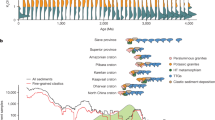Abstract
Trends of geophysical anomalies have made important contributions to local and regional structural studies within the North American continent1,2, particularly in examining the Precambrian basement underlying the relatively undeformed Phanerozoic sediments that cover ∼45% of North America3–5. Here we present a gravity trend map of North America, based on a horizontal Bouguer gravity gradient map6 produced from gravity data for Canada and the conterminous United States, and use it to define a continental mosaic of gravity trend domains akin to structural domains. Contrasting trend characteristics at gravity domain boundaries support the concept of the outward growth of the continent primarily by accretionary (collisional) tectonics. Gravity patterns, however, indicate a different style of tectonics dominated in the development of now-buried Proterozoic orogenic belts in the south`central United States, supporting a view that these belts formed along the leading edge of a southward-migrating Proterozoic continental margin7.
This is a preview of subscription content, access via your institution
Access options
Subscribe to this journal
Receive 51 print issues and online access
$199.00 per year
only $3.90 per issue
Buy this article
- Purchase on Springer Link
- Instant access to full article PDF
Prices may be subject to local taxes which are calculated during checkout
Similar content being viewed by others
References
Stockwell, C. H. in Geology and Economic Minerals of Canada (ed. Douglas, R. J. W.) Geol. Surv. Can. Econ. Rept. No. 1, 44–54 (1970).
Muehlberger, W. R., Denison, R. E. & Lidiak, E. G. Am. Ass. petrol. Geol. Bull. 51, 2351–2380 (1967).
Green, A. G., Hajnal, Z. & Weber, W. Tectonophysics 116, 281–322 (1985).
Dutch, S. I. Geology 11, 478–481 (1983).
Thomas, M. D., Sharpton, V. L. & Grieve, R. A. F. Geology 15, 489–492 (1987).
Sharpton, V. L., Grieve, R. A. F., Thomas, M. D. & Halpenny, J. F. Geophys. Res. Lett. 14, 808–811 (1987).
Condie, K. C. Geology 10, 37–42 (1982).
Sharpton, V. L., Grieve, R. A. F. & Halpenny, J. F. Geol. Surv. Can. Open File No. 1419 (1987).
Hoffman, P. F. Geol. Surv. Can. Pap. 87-8, 8 (1987).
Gibb, R. A., Thomas, M. D., Lapointe, P. L. & Mukhopadhyay, M. Precambr. Res. 19, 349–384 (1983).
Gibb, R. A. & Halliday, D. W. Earth Phys. Branch, Ottawa, Gravity Map Series Nos p. 36 (1974).
Klasner, J. S. & Schulz, K. J. Geology 10, 537–541 (1982).
Thomas, M. D. Geology 12, 57–58 (1984).
Wellman, P. J. geol. Soc. Aust. 23, 11–14 (1976).
Anderson, J. L. in Proterozoic Geology: Int. Proterozoic Symp. (eds. Medaris Jr, L. G. et al.) Geol. Soc. Am. Mem. 161, 133–154 (1983).
Bickford, M. E., Van Schmus, W. R. & Zietz, I. Geology 14, 492–496 (1986).
Sims, P. K. & Peterman, Z. E. Geology 14, 488–491 (1986).
Author information
Authors and Affiliations
Rights and permissions
About this article
Cite this article
Thomas, M., Grieve, R. & Sharpton, V. Gravity domains and assembly of the North American continent by collisional tectonics . Nature 331, 333–334 (1988). https://doi.org/10.1038/331333a0
Received:
Accepted:
Issue Date:
DOI: https://doi.org/10.1038/331333a0
This article is cited by
-
Tectonic divisions and accretionary model within Dharwar Craton: New insights from gravity surveys on status of Chitradurga Schist Belt
Journal of Earth System Science (2021)
Comments
By submitting a comment you agree to abide by our Terms and Community Guidelines. If you find something abusive or that does not comply with our terms or guidelines please flag it as inappropriate.



